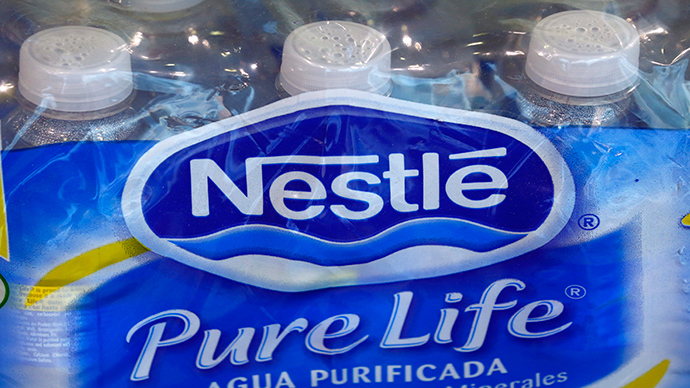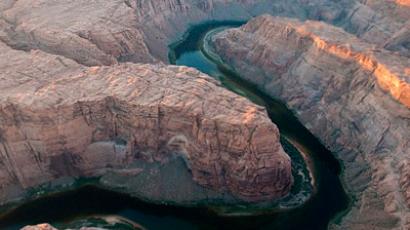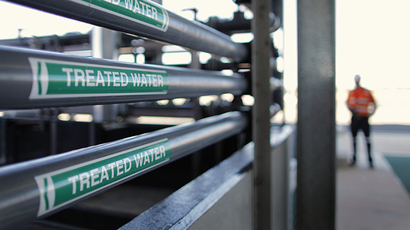Nestle continues to sell bottled water sourced from California despite record drought

California is facing one of its most severe droughts on record, which is hurting farmers and recreation alike. But despite water restrictions, Nestle is bottling spring water from the state and selling it, creating controversy alongside profits.
Nestle owns Arrowhead Mountain Spring Water, which has been
bottling water from a spring in Millard Canyon, Calif. for more
than a decade. The company’s 383,000-square-foot bottling plant,
which also packages purified water under the Nestle Pure Life
brand, is located on the Morongo Band of Mission Indians
reservation.
In January, Gov. Jerry Brown (D-Calif.) declared a drought state
of emergency in preparation for water shortages, especially
during the summer months. The drought has entered its third year,
and water restrictions have increased throughout the Golden
State.
But Nestle does not need to heed the emergency measures the state
has adopted. Since its plant is on a Native American reservation
– considered a sovereign nation by the US government – it is not
required to comply with state regulations.
The reservation is located in a Mojave Desert oasis at the base
of the San Bernardino Mountains, 85 miles east of Los Angeles.
Drawing water from that location, where just three inches of rain
falls each year, prevents water from seeping downhill to fill
aquifers of nearby towns struggling for water during the drought.
Throughout 2009, Nestle submitted annual reports to local water
districts detailing how much groundwater it was extracting from
the Millard Canyon spring. But since then, neither the company
nor the Morongo tribe has submitted those forms. Reports compiled
by the San Gorgonio Pass Water Agency show that the amounts drawn
from two wells in the canyon varied from a high of 1,366
acre-feet in 2002 to a low of 595 acre-feet in 2005, according to
The Desert Sun. In 2009, Nestle submitted its last report,
covering the water pumped from wells during 2008. The company
said it pumped 757 acre-feet that year, but none of the reports
were ever independently verified.
The Morongo did file a report with California that said 598
acre-feet of groundwater was pumped in Millard Canyon in 2013,
and three acre-feet were diverted. “Those amounts translate
to about 200 million gallons a year — enough water for about 400
typical homes in the Coachella Valley,”The Desert Sun reported.

Because of their sovereign status, the tribe has not disclosed
water levels within the aquifer or the wells on the reservation’s
land. Therefore, no one knows what impact the bottling plant has
on water supplies.
"Surface water is so rare and the biological communities
around these oases are so unique that these kinds of bottling
plants in the desert should give us pause," Peter Gleick, a
water researcher who is president of the Pacific Institute in
Oakland, told the Sun. "If they weren't pumping, the volume
that they're taking out would be going into either recharging
groundwater or providing some surface flows."
Gleick visited the Morongo bottling plant, located in Cabazon,
while researching for his 2010 book 'Bottled and Sold.' He said
that there was a small stream on the reservation, but that
vegetation seemed to have died back due to a lack of water flow.
He expressed concern with how dwindling water would affect the
ecosystem in the oasis.
"The reason this particular plant is of special concern is
precisely because water is so scarce in the basin," Gleick
said. "If you had the same bottling plant in a water-rich
area, then the amount of water bottled and diverted would be a
small fraction of the total water available. But this is a desert
ecosystem. Surface water in the desert is exceedingly rare and
has a much higher environmental value than the same amount of
water somewhere else."
If water weren't being pumped and diverted from Millard Canyon
for the bottling plant, that water would boost groundwater levels
in the canyon and would gradually spread downhill into the
Cabazon basin, Jeff Davis, general manager of the San Gorgonio
Pass Water Agency, told the Sun. From there, it should flow into
the Coachella Valley aquifer.
But, because of that diversion, the water isn’t overflowing out
of the Cabazon basin. In fact, the Cabazon Water District says
the aquifer is in decline, with more water being pumped out than
is flowing back in. The US Geological Survey database shows that
some wells in the area have been sinking between one and four
feet a year during the last decade.
The community in the surrounding area is torn on what to do. Some
argue that there is better use for water during the severe
drought, which has no end in sight. Others point out that the
bottling plant provides badly needed jobs.
"That's the highest, best use of water is drinking it,"
Riverside County Supervisor Marion Ashley said to the Sun.
"They're entitled to use the groundwater basin, too. Everyone
is. But it's just a shame that this water is not being used
locally. It's being exported," said David Luker, general
manager of the Desert Water Agency (DWA). He told the Sun that
DWA believes the Morongo should have to report its water use in
accordance with state policies.
Calvin Louie, the Cabazon Water District's general manager,
summed up the pros and cons of the bottling plant.
"Arrowhead provides a lot of jobs, and that helps the
economy,” he said. “On the other hand, Arrowhead has a
reputation of going into small communities and taking advantage –
and basically, pump them dry and 'good to the last drop.'”
Many fear that is the situation facing the Millard Valley,
although the Morongo tribe denies that their water source is at
risk.
"The Morongo Band of Mission Indians is a sovereign nation
with a long history of caring for the environment and of
environmental stewardship as it relates to air quality, local
habitats and tribal water resources," Michael Fisher, a
spokesman for the Morongo, wrote in an e-mailed statement.
“As responsible stewards of the environment, Morongo works
carefully with Nestle to monitor the plant operations and conduct
recharge and other environmental programs to ensure that these
water resources remain healthy and reliable for future
generations."















